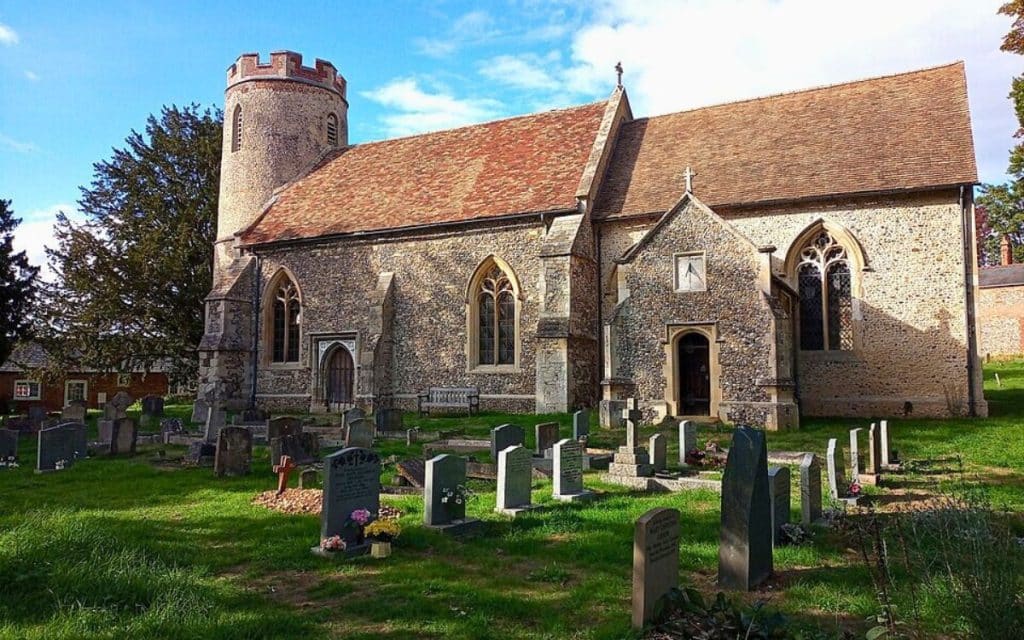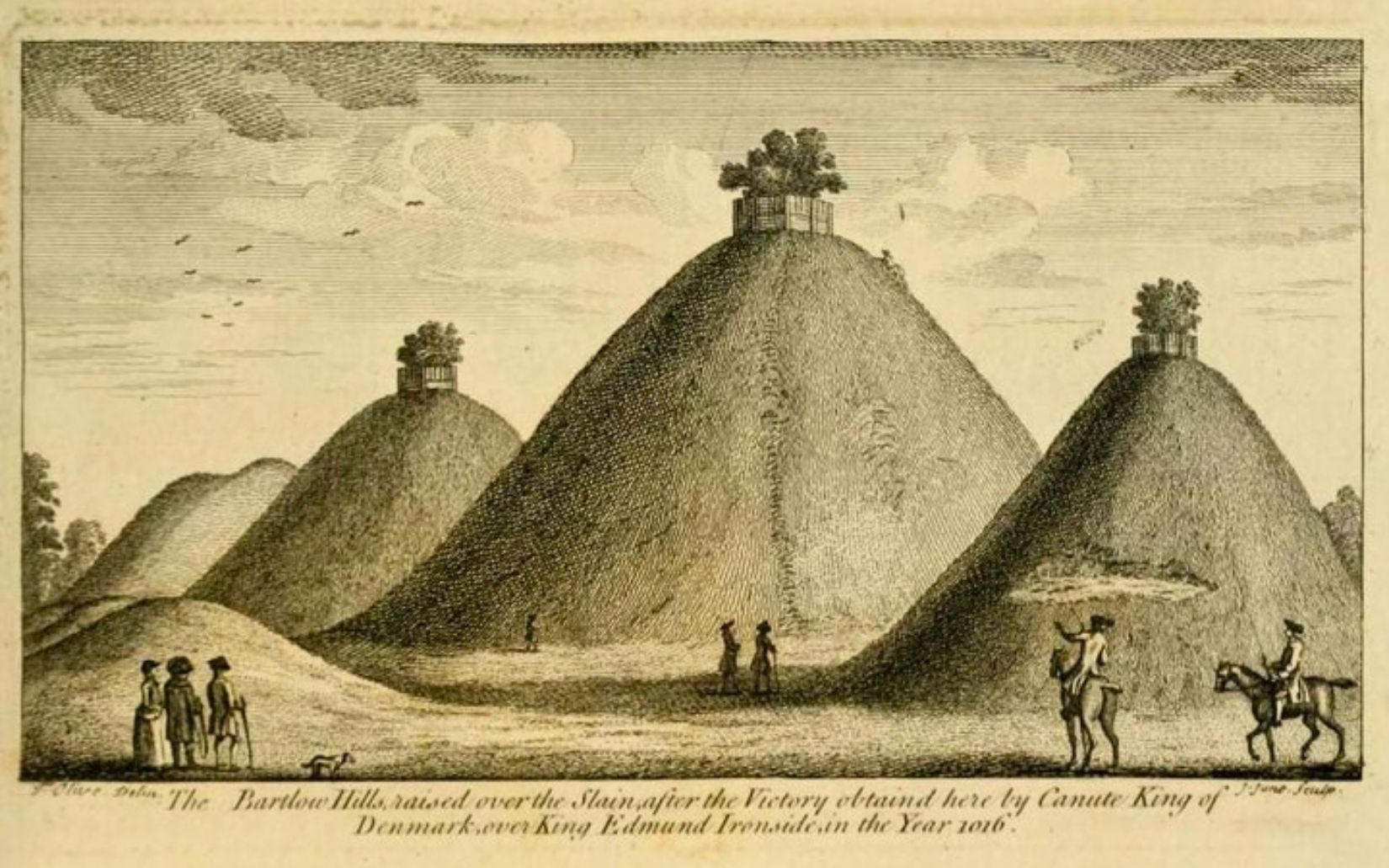The Bartlow Hills – once Essex’s own “pyramids” – weave together Roman burials, Saxon legends, and eerie folklore into one of Britain’s most mysterious ancient sites, writes RICHARD CLEMENTS

Hidden in the low-lying hills and quiet fields that were once Essex, now part of Cambridgeshire, sits a group of earth-covered mounds that have puzzled locals and curious passersby for centuries.
Known as the Bartlow Hills, or more dramatically, the “Pyramids of Essex”, these grassy mounds hold onto layers of history, from Roman rituals to whispers of things far harder to explain.
But their story stretches well beyond Roman times. Old stories tell of a battle fought here long after the empire faded, possibly during the reign of King Canute, and a nearby church whose ancient tower may still mark the spot. Though they aren’t carved in stone like Egypt’s pyramids, the Bartlow Hills seem to hold their own quiet magic, enough to draw in those with a love of legends and strange histories.
The Roman Footprint: A Landscape of the Dead
Not far from the village of Bartlow, the hills reveal themselves as Roman-era burial mounds, known as tumuli. These were raised sometime in the 1st or 2nd century AD and used to honour high-ranking individuals from the Roman community that once lived here. While seven were thought to exist originally, only four survive intact today. The tallest still rises above the landscape, quietly marking this place as Roman territory, long after the empire’s retreat.
Over the years, digs have turned up many Roman-era items, urns, pottery, glass bottles, and personal trinkets, each one shedding light on how the dead were honoured here. The size and richness of the mounds suggest they belonged to an important community, possibly linked to a villa or regional hub nearby. The mounds, still standing after nearly two thousand years, reflect a culture that treated death with lasting significance.
Stories passed down over the centuries hint that Bartlow saw more than burials. According to some versions, a violent clash unfolded here during King Canute’s reign in the early 1000s. As oral history tends to be, the details are vague, but many say the hills were used as a vantage point during the fight, perhaps between Canute’s army and Viking invaders or rival Saxon forces.
The terrain itself supports the idea. This area would have been relatively open even a thousand years ago, ideal for troop movement. And the hills, though older than the battle, could have served a strategic role. While no definitive archaeological evidence has confirmed that such a fight occurred here, the tale’s persistence keeps it alive in the region’s collective memory.
St Mary’s Church and Saxon Shadows
Just a stone’s throw from the mounds sits the Church of St Mary. At first glance, it’s a simple village church, but its round tower stands out. These towers are rare in England and usually date back to the Saxon or early Norman period, sometime between the 9th and 12th centuries.
Some locals think the church may have been built partly to honour those who died in the battle. Whether that’s true is still up for debate, but the tower’s age alone suggests the site has deep roots, possibly going back to the time of Canute. It’s not hard to imagine an earlier structure once standing here, slowly evolving into the church that remains today.

Given its long and tangled past, from Roman graves to tales of old battles and centuries-old buildings, it’s no wonder Bartlow has attracted ghost stories and legends over time.
One story suggests the hills weren’t just burial sites; they might’ve been shaped deliberately to echo the pyramids, maybe by a Roman official interested in Egypt. There’s no hard proof for that theory, but the nickname “Pyramids of Essex” has stuck and certainly adds to the place’s strange charm.
People have talked about buried treasure here for generations, and every now and then, real archaeological finds only help to keep those stories alive.
Locals tell of shadowy shapes moving between the mounds at dusk. Some speak of faint, eerie sounds, metal clashing, soft cries, caught on the wind. The old church tower nearby often finds itself at the centre of these stories, as though it remembers something the rest of the village has long forgotten.
Then there are the stories of tunnels running beneath the hills, connecting them to one another or the church. Some versions link these passages to Roman construction, others to medieval escape routes. A few believe they’re haunted, echo chambers for restless spirits tied to the earth above.
Bartlow Hills Today: A Landscape for Reflection
Today, visitors can wander the surviving mounds, where the hills blend into the countryside like they’ve always belonged. It’s not hard to imagine this same ground in Roman times, or during the turbulent years of Canute’s rule, layers of history overlapping in the same quiet field.
If you like places where history feels almost within reach, old stories linger in the air, and the landscape seems to remember, then Bartlow has something to offer. Whether it’s the archaeology, the folk tales, or just a sense that the past never really left, this place invites a slower look.
The Bartlow Hills, Essex’s quiet “pyramids”, are more than ancient graves. They are echoes in the soil, reminders of Roman ceremony, whispered legends of battle, and the enduring presence of an old round tower watching over it all.
Blending historical evidence with enduring local stories, this small corner of England carries a rare weight. Bartlow is where the past refuses to be forgotten, where burial mounds, sacred stones, and strange tales converge. A place where architecture, archaeology, and imagination continue to collide in the most haunting and beautiful ways.
Have you visited the Bartlow Hills, a hidden gem in Cambridgeshire? Tell us in the comments section!



